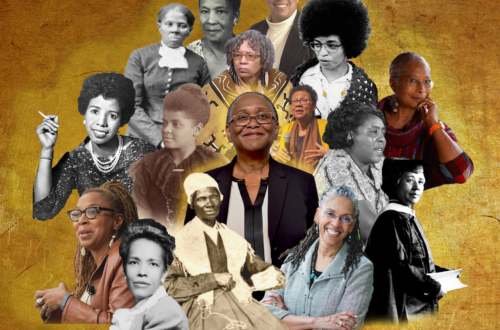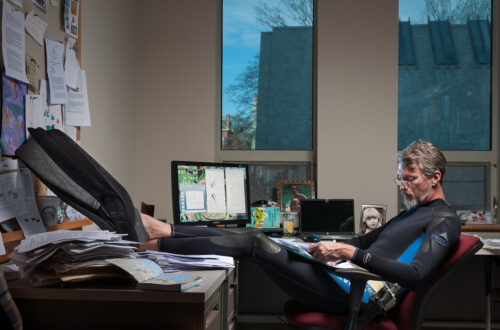
showing/thinking: Toby Emert
Gordon (Toby) Emert is a professor of theatre at Agnes Scott College. He holds a B.A. from Longwood College, an M.Ed. at The College of William and Mary, an M.A. from the University of Virginia, and a Ph.D. from the University of Virginia. Dr. Emert’s teaching and scholarly interests include applied theatre, theatre for youth, digital narrative/storytelling, children’s and young adult literature, and LGBTQ+ issues. Professor Emert’s reflections on his scholarly thinking and process, from the 2014 Dalton Gallery exhibition showing|thinking, a series of exhibitions that highlighted the work of faculty and staff on campus:
“Imagination can’t create anything new, can it? It only recycles bits and pieces from the world and reassembles them into visions.” -Tony Kushner, Angels in America: A Gay Fantasia on National Themes
I understand the significance of a distinct through-line in conveying the arc of a story, but I tend to notice the loose threads hanging from the edges of the plot points—the “what if ’s,” the “and also’s,” the “but maybe’s.” It takes effort for me not to pull on these threads to see what the story is made of. I am not a skilled raconteur, but I grew up in a family of storytellers, people who were preternaturally clever and dramatic. I remember sitting in the circle with my father and his brothers on winter evenings as they tied dried tobacco leaves, readying the crop for market. There was a certain kind of grace in the chore, which, with practice, the hands learned to replicate with precision. And there was a polished rhythm to the stories they told—an improvisational understanding of how to make a too-familiar tale twist unexpectedly without missing the punchline. It was my job to separate the sticky leaves … and to listen.
My mother’s family were stern folks: practical and penny-wise. Their stories, unlike those of my father’s family, were crisp and intentionally cautionary. My mother’s mother spent her winters alone, quilting at a wooden frame she kept assembled in the kitchen. She was a collector.
She filled trunks with fabric scraps, mismatched spools of thread, and cotton batting. Quilting looks like quiet work, a solitary preoccupation, but it requires a remarkable perspicuity for how disparate materials can be pieced together to create something entirely unexpected, sometimes even stunning. It is the work of fabricating a world one stitch at a time. In this way, it requires faith; it requires vision.
I am interested in faith. I am interested in fabrication. I am interested in stories. I am interested in promise. I’m intrigued by possibilities, by what can be fashioned from what already exists, by how any idea can be repurposed. I am often content to reassemble, rework, and reimagine. When I was younger, I likely misunderstood my own inclinations, thinking it important to create a vision, a way of seeing the world that appeared more narratively precise, more elegantly articulate. I expect I considered that my thinking would naturally mature and that I would learn to refine my focus. It has taken many years for me to embrace the disparity in my interests and to, at least occasionally, celebrate the allure of distraction. I now know that I can generate projects for myself that beckon me to work impressionistically, slowly sussing out connections that are not readily apparent. I’m learning to do this work more explicitly—to be intentional in indulging my penchant for gathering bits of what appear to be unrelated ideas and forcing them together to render something unexpected and new.
This style of thinking invites me to indulge in professional projects that seem, upon casual inspection, to be, at best, mismatched. At moments I am compelled toward the introspective work of the poet, content to spend hours tacking together a few lines of verse that I may never publish. In those quiet moments of solitary labor, I am surprised that I could want to journey into the chaotic vision that is a classroom of children, where I have tended to hone my own instruction and to conduct research on learning and learners. I may be as captivated by the ingredients in a recipe as I am by the idea of directing a play or composing a short autobiographic film, editing the manuscript of a children’s picture book, planning a professional development workshop for teachers, attending to the aesthetic considerations of the look of a PowerPoint presentation for a conference talk, drafting the structure of a new website, or reviewing a theatrical production or interviewing a young adult novelist.
I have come to consider this patchwork of interests and the projects that emanate from them not as a failure of the kind of studious focus that leads to specific expertise, but as a grid of possibilities, easily transversed, mingled, reassembled, and fused. A generative palette of delusions and promises.




